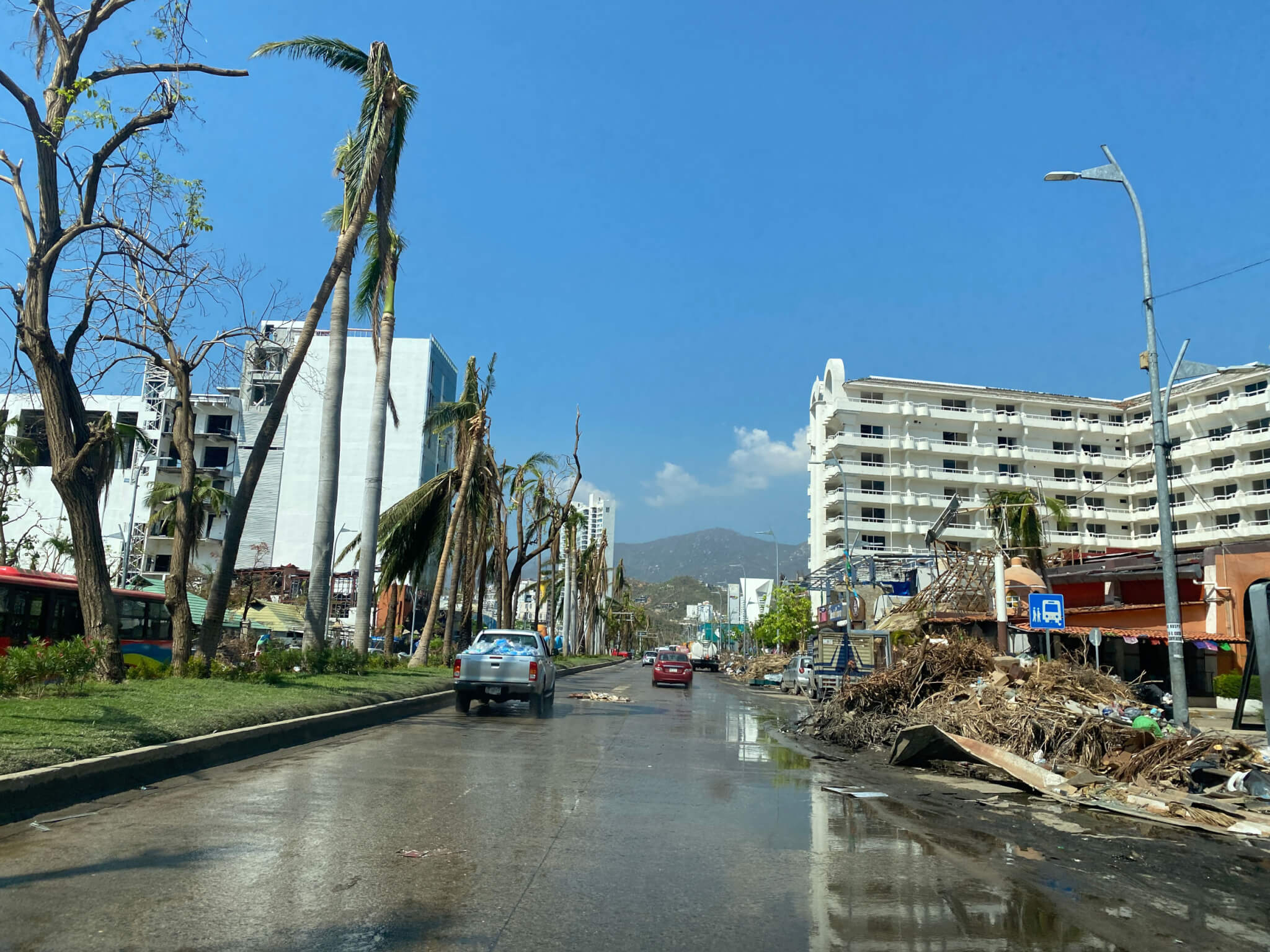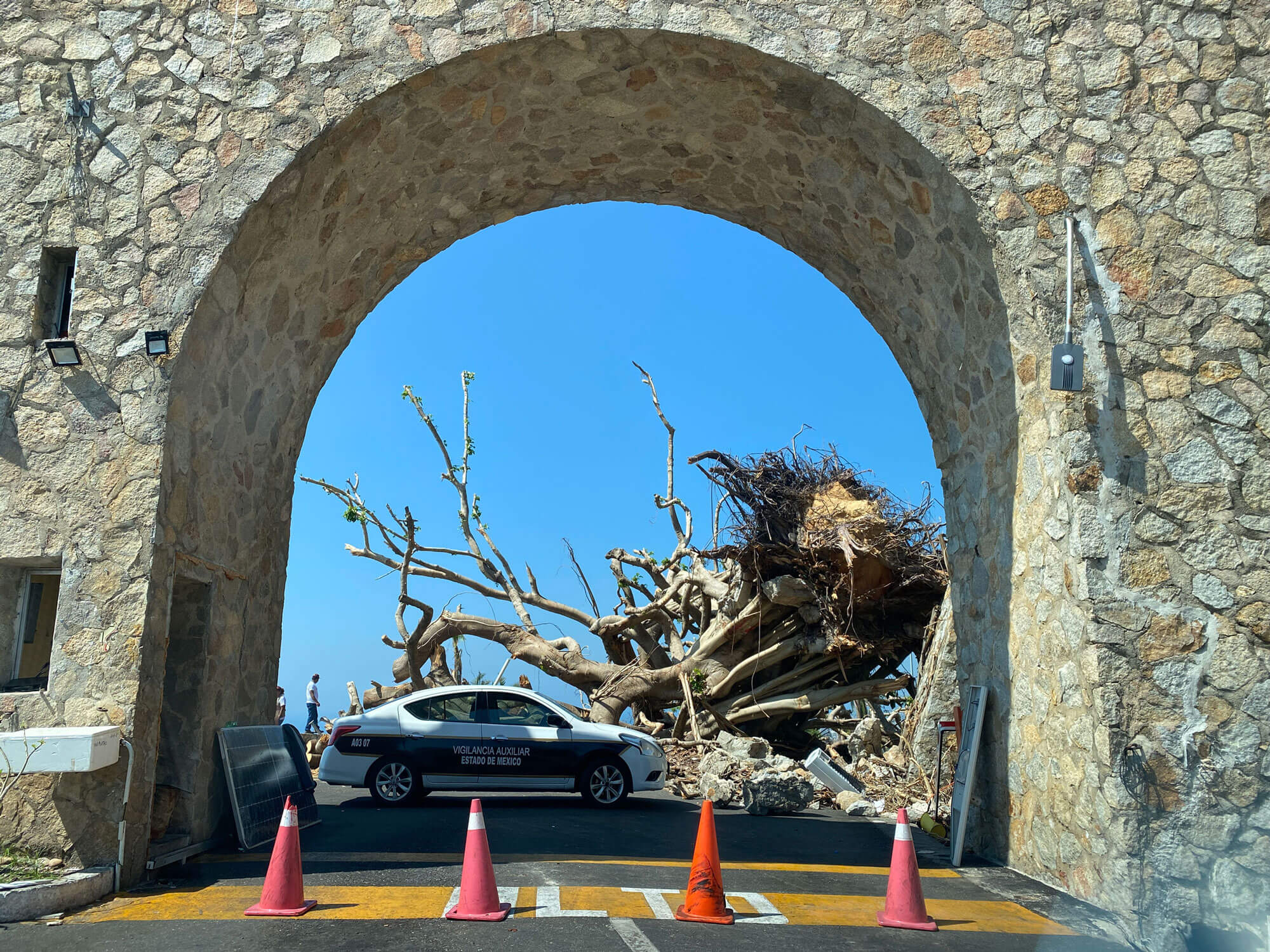Building skeletons, desolated avenues, and piles of debris is what Hurricane Otis left behind in Mexico’s southwest Pacific coast after forecasts failed to predict the October 25 storm’s strength as a Category 5 hurricane. As the situation evolves, architects, and urban planners in Mexico reflect on Acapulco’s urban fabric and their discipline’s role in the time of humanitarian crisis.
Government tallies report 220,000 damaged homes after the “nightmare scenario,” estimated to require a $4.1 billion (MEX$61.3 billion) recovery plan that includes humanitarian aid, tax breaks and the reconstruction of the tropical paradise’s infrastructure.
Acapulco is renowned for its former glory and a beloved coastal destination for Mexican and American tourists alike—John F. and Jackie Kennedy, Bill Clinton, and Elizabeth Taylor have all vacationed on its beaches. The city’s “DNA” is rooted in its tourism legacy. Iconic developments like Mario Pani’s Yacht Club (1955), William Rudolph and Leonides Guadarrama’s The Hotel Princess Mundo Imperial (1971), and the modern apartment buildings and hotels of the Diamante neighborhood resemble Miami’s landscape lining a coastline where old and new meet as a melancholic facade for glamorous tourism and impoverished informal settlements.

Structures located on the shore, like those in Diamante, were damaged during Hurricane Otis, while neighborhoods farther away from the beach were destroyed, per a grading system by the Copernicus Management Service. In at-risk geographic locations like Acapulco devastating climate events are expected to become more common. “What we are seeing from studies and from observations is that more hurricanes are intensifying faster, and more hurricanes are intensifying to a higher level,” senior climate scientist for the Union of Concerned Scientists Astrid Calas told AN. “The predictions are not as bad as what we’re seeing, what we’re seeing is worse.”
The evolving climate crisis highlights a need for resilient construction, and while hurricane-resistant materials and building technology exists, it can be difficult to achieve widespread use in a country like Mexico, where stark inequalities and lack of governance may limit their use.
With a population of almost one million people, 7 out of 10 live in poverty in Acapulco. Many live in tin roofed houses constructed with lower budget and less resilient construction materials—such as glass not built to withstand heavy winds and flying debris—that were damaged by the hurricane. Mexico City–based architect and urban planner Jose Castillo of firm a|911 pointed out in an interview with AN that many residents have no choice but to use these materials and methods. “But one can also not ignore that for many people, it was the only way to achieve a house,” Castillo said.
A week after Otis, Castillo traveled to Acapulco to deliver aid packages, noticing damage around the city. Shorter houses were crushed by fallen billboards and water tanks, and taller buildings were stripped of their facade, leaving just the internal structure standing, and mounds of debris surrounding them. Better regulation on the placement of these objects, buildings, and development could have prevented further damage.
“If you go to Acapulco, you’ll see many areas with irregular settlements that appear to have no regulations in terms of heights, openings, or facades,” Mexican architect and professor Arturo Ortiz said. He attributes it to lack of governance and corruption across the country.

Hurricane Otis is not the first disaster to strike the country, other natural catastrophes of note are the destructive 1985 and 2017 earthquakes in Mexico City. During these moments of humanitarian crisis, architects and urban planners face an existential crisis, reflecting on the past to understand their role during these events.
“We tend to kind of look at opportunities for work in problems that are fundamentally humanitarian,” Castillo said, “it’s important to try to understand where our capacities as a discipline are the most useful.”
William Brinkman, philosophy and architecture professor at Universidad Nacional Autonoma de Mexico (UNAM) in Mexico City, recalled being at the early stages of his tenure when the 2017 earthquake occurred. “We realized as a department that what is missing is an enormous amount of basic understanding needed for immediate response,” Brinkman said. At the time, there were efforts to train the almost 8,000 undergraduate architecture students at UNAM for risk assessment, but budgetary constraints put a hold on the initiative.
Brinkman argues that beyond the design and form, “architecture is a historic practice of logistics and cybernetics, with the understanding of cybernetics as the art of governing.” Under this framework, architects may offer logistical help to assess and react to disasters.
“The most important aspect where designers can contribute is post-disaster assessment…both at the level of physical infrastructure, but at an institutional level…to identify the vital with alignment with the less vital,” Castillo added. “I think that the tradition to think about rebuilding is at the core of our discipline. But I think there’s also a possibility to embed it with new awareness, new empathetic sensibilities.”
And while environmental disasters like Otis highlight infrastructure and institutional flaws, they also drive change through reflection. Ortiz referenced the 1985 earthquake as a paradigm shift for stricter building regulations in Mexico City, with less buildings having collapsed in 2017. “In Mexico City, regulations changed, but corruption did not end. Everything changed, but buildings did not fall again,” he said.
What is to become of Acapulco is uncertain, and its reconstruction is filled with fantasies and constraints, and opens the door to imagining what its future holds. Castillo added, “the DNA of Acapulco has a possibility to be kind of, if not replicated, but at least to be rethought today.”











